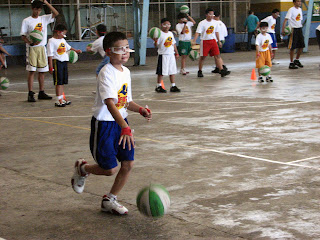ALA: Visionary with a Heart
ALA Boxing. Where do we start? And why did it all have to end? Philippine sports, most specially in Cebu, is mourning the death of loved one, with many having a hard time accepting it and moving on. After all, how is that possible with a phenomenon like ALA Boxing? It’s like having a well-conditioned athlete at his prime succumbing to COVID 19. Yet ironically, COVID 19 did knock ALA out. COVID has been one serial dude, hasn’t he?
As a boxing fan, I followed ALA boxing since the start of
their professional boxing promotions in 1989. Yes, I’ve been around and age is
catching up on us, but I’m not afraid to declare that I was there when it all
started. Brix Flores, Gerry Peñalosa, Edito Villamor, Andy Tabanas, Ramy Dumpa,
Noel Tuñacao and a few others were the big names then. They were followed by
Jun Gorres, Joma Gamboa, and Edmund Villamor. The Golden Boys Malcolm Tuñacao,
Rev Santillan and Randy Suico, though not officially ALA Boys, took their turn
to shine before the new generation ALA Boys stepped up: Rodel Mayol, Wyndel
Janiola and company. All of them were part of a host of ALA Boys who donned the
classic black trunks of the ALA Boxing Gym and proudly carried the colors of a
program which was larger than life. Today, four-division world champion Donnie
Nietes, Milan Melindo, Albert Pagara, Jeo Santisima, Melvin Jerusalem, KJ
Cataraja and the current crop of ALA boxers will have to find a new home, a new
manager or a new promoter who will be willing to take them under their wings.
What can we learn from ALA Boxing? For starters, they
showed us how a sports program must be run. It all started at the top with a
person named Antonio L. Aldeguer, a.k.a. ALA. He was passionate about his
boxing and did something about it. Being a tickler for only the best, he put up
a complete package of a program that started with grassroots boxing. The ALA
Boys were not products of an overnight machinery. They started in their teens,
trained religiously under their coaches and dominated the amateur boxing scene.
And when the timing was ripe, they turned professional and started to catch the
attention of a boxing-mad Cebu before opening up to the entire country. This
was the cycle of churning out boxers through the past 35 years. Each time an
ALA boxer was on top of the ring fighting as a pro, always present were a bunch
of young upstarts who dreamed of becoming ALA boys themselves. It doesn’t come
as a surprise then, that several boxers would turn pro at strategic times of
their careers on a regular basis. They were the waves or generations of ALA
boxers who kept boxing fans trooping to ALA events and hoping that some would
eventually win a world championship.
With a school of young aspiring boxers, a boxing gym was
necessary. But this wasn’t a simple sweat shop. A large section of the company
property of ALA in Mandaue (some say Nasipit, Talamban) was set up with a world
class, well-ventilated gym that included two boxing rings, punching bags, speed
balls, double end bags, weights, a basketball court, an oval and a dorm for the
boxers. The gym wasn’t exclusively for the ALA boys as boxers from other
countries like Japan and the U.S. would spend time to train there. Juanito
Ablaca led the first trainers until ex ALA boxers led by the Villamor brothers
and Peter Cuizon took over.
ALA boxing events were the benchmark for all boxing
promotions. Leaving no stone unturned, the Pinoy Pride series of fight cards
(46 of them) were designed to give Pinoy fans a taste of Vegas-style boxing.
And they didn’t disappoint, with an event management schedule that was loaded
before, during and after the actual event. Watching a Pinoy Pride event at the
Waterfront Hotel, MOA Arena, Araneta Coliseum, Solaire Hotel or Resorts World
made one experience that Vegas touch. Press conferences and a PR campaign were
a standard and the most impressive thing here was that ALA made sure that the
Cebu media would be part of every event even if the partnership was with
ABS-CBN. ALA events were the only boxing cards in the country where the Cebu
media would be sitting beside the Manila media people. And this included trips
to Dubai and the U.S. When one walks into a Pinoy Pride event, one can’t help
but notice the TV lights, cameras, red carpet, cordon for the VIP areas,
bouncers, ushers and beautiful round girls. ALA made sure that Pinoy Pride was not
just about boxing. It was an experience.
Amidst all this though, one of the most amazing things
that ALA has done was to develop young, poor and deserving athletes to become
better human beings. While we’ll hear a lot about the champions that they produced,
we won’t get to see the entire lot of ALA boxers who have moved up in life as
well-respected individuals. More than the medals and championship belts, this
is what I feel ALA really wanted to achieve. This is the ultimate benchmark
that will go unmatched.
Salamat ALA for blazing a trail and setting the standard.
Truly a visionary with a heart.



Comments